Contents
At home, rabbit food is placed in bowls, jars and other similar containers. But a mobile animal often likes to play pranks, which is why the grain from an inverted feeder ends up on the floor, and immediately wakes up through the cracks. Bunker feeders for rabbits installed in the cage help to reduce feed consumption, as well as simplify the feeding process.
Why is it beneficial to put bunker feeders on rabbits?
To answer this question, put a bowl of grain and observe the habits of an eared pet. While the rabbit is hungry, he will calmly chew the food served to him. After satisfying hunger, the animal walks in a cage. Naturally, the bowl with the rest of the grain will be upside down. The rabbit can get angry, hit the floor with its hind legs, grab the feeder with its teeth and throw it around the cage. You can also watch how rabbits rake food with their front paws. And it does not matter what it will be – grass or grain. Here, in order to rationally use the feed, bunker feeders for rabbits are needed.
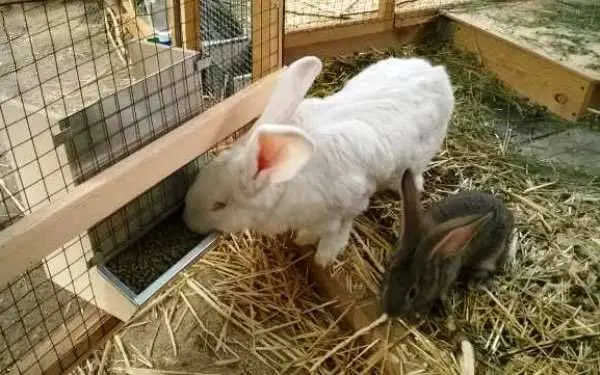
Another important point is food contamination. Even if the rabbit did not turn the grain out of the bowl, he will definitely stain it with droppings. Over time, the food will be eaten, but the risk of the animal becoming sick increases. Bloating and indigestion are especially common. By installing a bunker feeder for rabbits in the cage, the animal will always receive clean feed in a timely manner.
The bunker design of the feeder allows you to make a supply of feed for several days. The owner may not worry if he did not arrive at the dacha on time. The animal will be fed.
Independent production of a galvanized bunker feeder
It should be noted right away that it is better to make do-it-yourself feeders for rabbits from metal. A 0,5 mm thick galvanized sheet is perfect. Sometimes beginner rabbit breeders practice making wooden feeders, believing that it is easier this way. Indeed, the tree is easier to process, but rabbits love to gnaw it. So galvanized sheet is the best material for the hopper feeder.
For the manufacture of the structure, you will need to draw up drawings. We have shown an example of a circuit in the photo. All fragments are placed on a galvanized sheet, after which they are cut out with metal scissors.
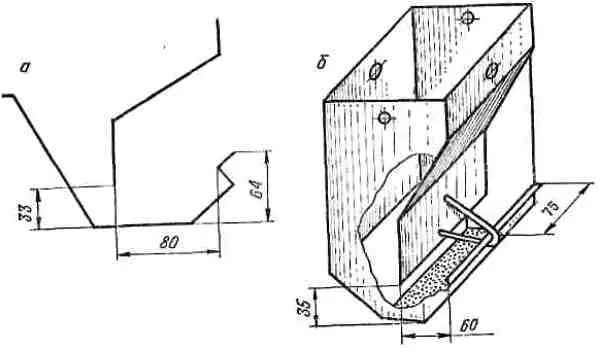
For the feeder, it is important to provide a top cover so that debris does not get into the feed. You also need to think about fastenings, because the structure will have to be fixed to the cage wall. The feed from the hopper will be poured into a tray that resembles a small trough. For its cutting, we offer to see the drawings. On the right in the photo is a tray pattern, and on the left is a feed limiter.
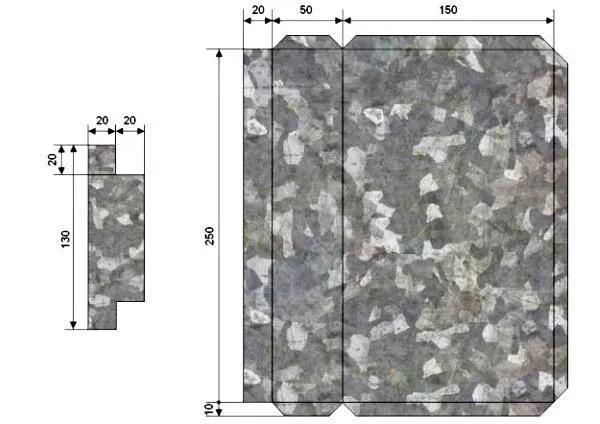
The above scheme is designed with optimal dimensions for standard cages. If you need a large feeder, then all fragments can be proportionally increased at your discretion.
So, there is a drawing of a bunker feeder, you can start making it:
- The feeder consists of three main parts: a tray, a back wall and a front wall. The limiter is an optional fourth part, but it is also desirable to make it so that the rabbits rake out food less. Making a tin feeder begins with a tray. To do this, a fragment cut out of galvanized steel is folded along the drawn fold lines. It is important to leave a 1 cm allowance at the joints. They are needed to connect the structure.
- To reduce the number of joints, the sides and back wall are made from a single piece of galvanized steel 37 cm long. It is bent in width, divided into three parts. The result is two side shelves 15 cm wide, and a back wall 25 cm wide.
- The front wall is also made from one blank 27 cm long. On a galvanized fragment, 3 bends in width are obtained. The dimensions of each shelf in order: 13,14 and 10 cm.
- Now it remains to put all the details together. If everything fits, holes are drilled at the joints where allowances were left. The connection is made with rivets or bolts.
- To make the feeder closed, a rectangle of 15×25 cm in size is cut out for the galvanized hinged lid. The workpiece is attached to the hopper with hinges.
As you can see, making a galvanized hopper feeder is easy. It is only important that its minimum capacity is calculated on the daily rate of feed.
The video shows a metal feeder:
Production of a feeder from a galvanized profile
A neat and fast bunker feeder for rabbits from a profile with a section of 100×40 mm will turn out. The photo shows a drawing with dimensions. All these fragments need to be transferred to blanks.
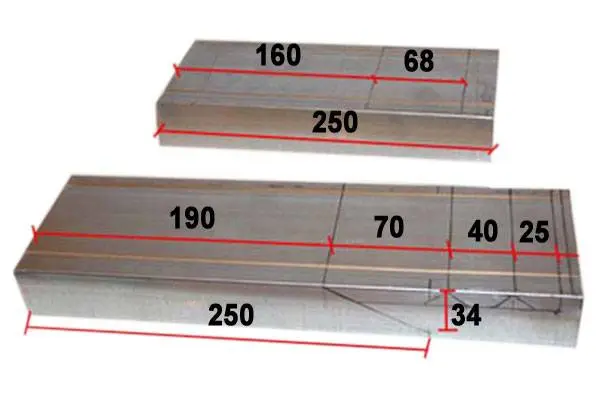
The following photo will help you understand the order of work, as well as correctly determine the place of the cut and fold.

Let’s look at the sequence of how to make a feeder from a profile:
- After marking the profile, according to the presented scheme, cuts are made with metal scissors and excess sections are removed.
- The lower part of the workpiece, as shown in the photo, is perforated with an electric drill. There will be food available for the eared pet.
- Along the fold lines, the workpiece is given the shape of a feeder. Holes are drilled at the joints, after which a screed is made with rivets. Two hooks made of galvanized pieces are attached to the back side. They are needed to hang the structure on the cage wall.
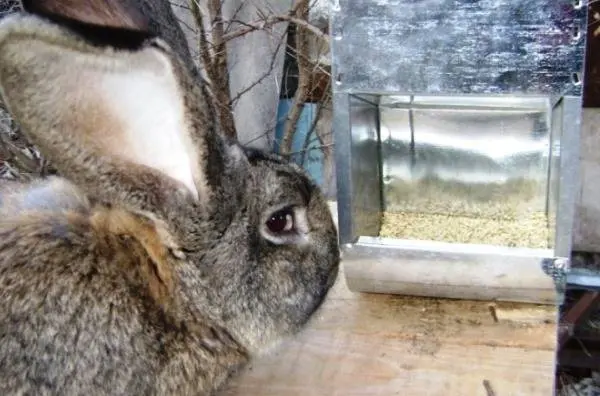
On the video feeder made of steel profile:
This type of bunker feeder is designed for one rabbit. In a large cage, you will have to install several such structures.
Making a bunker-type feeder from other materials
So, a reliable do-it-yourself bunker feeder for rabbits is made of galvanized steel. And from what else can you make the simplest design for the first time?

Let’s take two ordinary PET bottles from juice with a wide neck. For their base from boards or plywood 10 cm wide, you need to make a frame. Two strips are fastened at an angle of 90оto form the letter “G”. One of the bottles is screwed to the bottom shelf with self-tapping screws, having previously cut out its side part. The second bottle is fixed to the vertical shelf with clamps so that its neck enters the cut window of the lower container, but does not reach 1 cm to the wall. At a vertical container, the bottom is cut off for most of the circumference to make a folding lid.
On this, the bunker structure is ready. The plywood frame is attached to the wall of the cage, and dry food is poured into a vertical bottle. As the rabbit eats, the grain will fall out through the neck of the hopper into a horizontally fixed bottle.
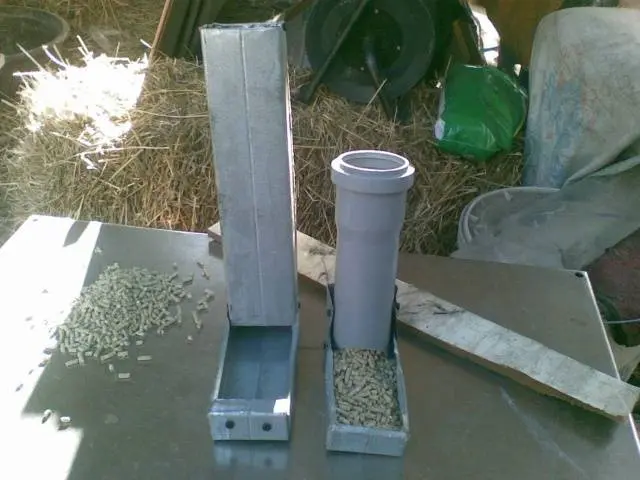
A similar design can be made from a pipe, as shown in the photo. A piece of galvanized profile is used as a tray. For the bunker, a piece of about 50 cm of sewer PVC pipe is cut off, a recess is cut from below for spilling the feed, after which it is fixed with self-tapping screws to the tray.
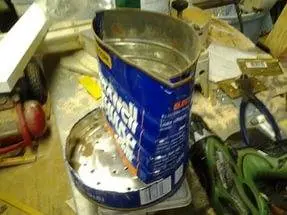
The next option is presented from a tin can. It needs to be cut in half, leaving about 5 cm of the side near the bottom. The side part cut off from below is completely separated from the can. To do this, make two cuts from top to bottom. From the resulting piece, the front wall of the bunker is bent, and fixed with rivets. The result is a design, as in the photo.
There are a lot of ideas for rabbit feeders. The main thing is to carefully remove metal burrs so that the animal does not get hurt.









